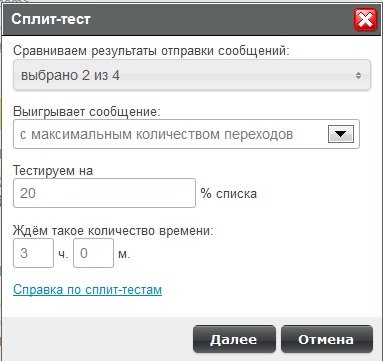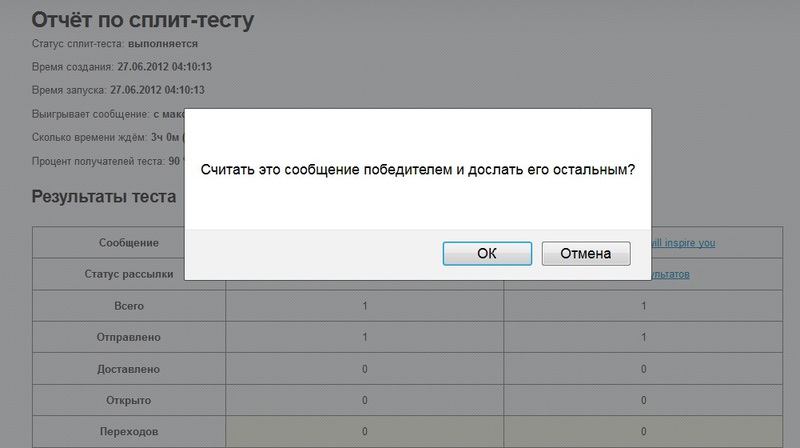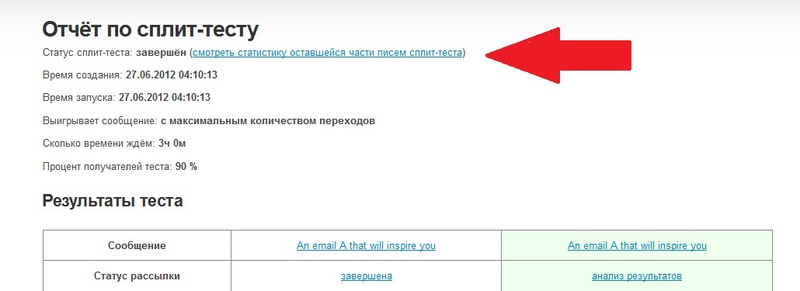Split testing: how it works with us

At one time, one of my colleagues started working in a new place, and he was expected to urgently and rapidly increase the pace of sales of sports equipment. In particular, active promotion through mailing lists was supposed. His situation was complicated: the volume of work was large, and everything had to be done “yesterday”. While the client base is new for him, and he knew little about it at that time. In order not to hit the face with dirt, he began to slowly take small measurements through split tests every time he did the mailing. As a result, he figured out the base, customers loved his mailings, and the store began to gradually increase turnover.
Understanding the preferences and preferences of your customers, guessing wishes, creating an irresistible desire to buy from you is what is truly valuable to you. Various polls, questionnaires, expensive marketing research, long thoughts on the results of promotions and sales are used. Everything, just to please the client. You always want to avoid this whole “tyagomotin” and “probe” your base in a less costly and time-consuming way. One of such methods is split testing.
Standard test
And I’ll disappoint you right away, not every mailing system has the functionality of split testing. Most often, the testing process looks rather cumbersome. You select a part of your mailing list, break it into two random groups and send two different campaigns (group A and group B, from where testing got its second name - A / B testing). After that, you again return to the newsletter and manually check the statistics of each of the two letters, compare it and select the winning letter. You can check the number of open letters, or the number of clicks - any parameter that you wanted to check before starting the test. And then the winning letter is already sent to the rest of the base as a real campaign.
It really takes time, which is almost never there. Despite the fact that no matter how you are loaded, it is understood that you repeat this procedure every time. And if you don’t do this, it means that supposedly you are not such a good marketer or manager. This is of course an unpleasant undertaking, provided that the data are processed manually, at a fast pace and a large amount of work. But without split testing, you are forced to work with your base “blindly”, in practice of real campaigns, suffering luck and defeat “in real time”. As a way out - an order of marketing research, which can fly out a pretty penny.
In fact, do not be alarmed if the mailing system wants to stay on the market, it is obliged to rid you of all this, and give you the opportunity to do mailings easily and naturally, when you need it or if you just want it.
Automated Testing
UniSender offers convenient functionality for split testing, which allows you to conduct the entire test in an automated mode and reduce the processing time of the results to a minimum. As a result, your testing will consist of several simple steps, which we already wrote about in a previous post .
How it works
After you have created two letters for the test, you do not click on the send button, as usual, but on the “split testing” button, after which you will be prompted in the pop-up window to select your testing parameters, including the percentage of your database that you will be use. This way you don’t have to select the segment “manually”, which would definitely take extra time. You can choose a segment within a segment: if when creating a letter, you choose that it will go to a specific segment of your database, then the split test will be carried out only within this segment.

The system itself will prompt you to choose a wider list if you include too few addresses in the mailing list. In our case, we decided to send a test mailing to a list consisting of 4 addresses, so we were given the task of the system to send an email to 90% of the base. In the mode of using a real database, of course, it will optimally use no more than 10-20% of it for the test. After that, you can monitor how the newsletter goes in real time:

If it is obvious that one letter is ahead, you can click the “consider winner” link until the newsletters end. The letter, which obviously broke ahead according to the given indicators, the system will automatically send to the remaining list of contacts:

After that, the split testing is considered completed, and the rest of the base receives a "winning" newsletter. You are invited to follow the results of the mailing, which you can click on in the same window:

You can follow how each mail is sent in a separate window. You will also see the results of the winning letter, which is sent on the remaining base:

As a result, you get several advantages at once:
- automation of testing launch and selection of the base segment
- real-time data analysis
- visibility of the information provided
- the ability to influence the course of testing in manual mode
In our practice, there was a case when a young colleague decided to send it on Friday evening. The head of the department was categorically opposed and had a very low opinion of the whole idea: it is traditionally believed that on Friday night there is not a soul at the computer, and no one will simply read the newsletter. The employee did not want to look like a fool in the eyes of the authorities, so she suggested making a split, since she had reason to believe that the newsletter could be successful. Oddly enough, she was right. In the client base of the dating site, which they promoted, there were many users who, for some reason, spent Friday evening not on TV and not with friends, namely on the computer. As a result, the newsletter resulted in a modest but traffic that the company could not have received without its initiative.
Little tricks
Ideally, split testing should be done with each of your newsletters. But if with standard systems it would turn into an endless waste of time with manually selected segments and manually compared results, with Unisender it is pretty fast. It will differ from ordinary mailing with just a few clicks.
Thanks to split testing, you will be able to "probe" your base in the most detailed way. You will not need to order additional marketing research of your customers and allocate a budget for this, since with each of your newsletters you will conduct mini-testing.
An important point is a properly constructed collection of information about your database. If you own data on the age, gender, geography of your leads, you can segment your database in more detail. In this case, you can do, for example, split-mailing only to women, or only to clients from 25 to 35 years old, for example. Thus, you can “examine under a magnifying glass” each segment, find out which messages a particular client is more likely to respond to when he is more available for your mail, and much more.
Study Options
For the objectivity of the test, two identical letters are taken, which differ in one parameter. The most complete list of writing options that you can test using the split test might look like this:
- Letter subject
- Headline
- Content \ Offer
- CTA (Call to Action)
- Design and Pictures
- Day of the week and time of dispatch
- Grounding Pages
- Personalization
- Sender Field
- Shipping frequency
